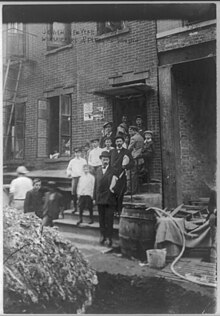User:Grackling/Jewish American literature
| This is the sandbox page where you will draft your initial Wikipedia contribution.
If you're starting a new article, you can develop it here until it's ready to go live. If you're working on improvements to an existing article, copy only one section at a time of the article to this sandbox to work on, and be sure to use an edit summary linking to the article you copied from. Do not copy over the entire article. You can find additional instructions here. Remember to save your work regularly using the "Publish page" button. (It just means 'save'; it will still be in the sandbox.) You can add bold formatting to your additions to differentiate them from existing content. |
Article Draft[edit]
Lead[edit]
(Lead is already provided in JA Lit article.)
Present Day[edit]
Modernism is a critical component to contemporary Jewish American literature. Fleeing the persecution of pogroms and anti-Semitic policies in Europe, two million Jews settled in the United States between 1880 and 1924, marking a significant cultural break with the past.[1] Themes in modern Jewish American literature expresses the difficulties of assimilation: while Jewish-Americans embraced American identity, they sought a decidedly Jewish approach to their literature.[2] Books like Saul Bellow's Dangling Man portrays the difficulty of assimilation and adapting to materialist urban consciousness.[3]

Post-1945 Jewish-American literature embrace approaches to writing centered in the postmodern. Didacticism, or telling stories for the purpose of teaching a moral lesson, is important to the writers Meyer Liben, Lionel Trilling, and Delmore Schwartz, who interweave Jewish philosophical discussion with self-identity as a basis for critiquing post-war America.[4] For instance, Liben adopts a meta-fiction as a means of exploring art and sensibility and their connection with Jewish identity.[5] Self-portraiture is another way Jewish-American writers confront identity, with Robert Mezy and Henry Roth investigating the conflicts between secular and religious life, English against Hebrew and Yiddish, and community transcending language.[6] Since the 1960s, different facets of Judaism, such as the orthodox, reform, and secular, are further stratified and entangled through the works of Saul Bellow and Chaim Potok.[7] These forms of literature are partly in response to antisemitism, reclaiming the tropes and histories that instigated the exodus to The United States, and ultimately transforming language to reflect the experiences of the Jewish diaspora.[8]
Jewish American Speculative Literature[edit]
Speculative genres, like fantasy and science fiction, are important in post-Holocaust Jewish American literature. However, science fiction produced by a Jewish writer does not automatically suggest a work of "Jewish science fiction," as it should concern issues of Jewishness or feature prominent Jewish characters.[9] For example, Isaac Asimov is an iconic science fiction writer with a Jewish background, yet his stories do not necessarily contain a Jewish element to them.[9] Examples of foundational speculative Jewish literature include Michael Chabon's 2007 book, The Yiddish Policeman's Union, and Jonathan Safran Foer's 2016 novel, Here I Am.[10] Nonetheless, the earliest science fiction writers were New York Jews, including Jerry Sigel and Joe Shuster. These early science fiction Jewish writers based in New York City led to works like Iron Man and I, Robot, having tremendous influence on the trajectory of speculative literature.[11]

A core theme in Jewish speculative literature is the literal and metaphorical destruction of Israel. American Jewish writers often depict Israelis in a disparaging manner, as Zionistic idealism is converted to aggressive self-righteousness targeting minorities, featuring the moral and political crisis in the country.[10] Yet, Israel remains a symbol of Jewish power and independence. In response, Jewish-American writers have marked a disassociation from Israel and Israeli Jews in an effort to redefine post-Holocaust identity.[10] Chabon's The Yiddish Policeman's Union, for instance, imagines a reality where Israel is destroyed soon after its formation, and Jews establish a homeland in Alaska with Yiddish as the central language. Chabon's book challenges the trope of suffering Jew and images of ghettos and concentration camps by creating a "tough Jew" character, along with presenting Jews as mobsters, swordsmen, and American soldiers, intentionally refraining from the Israeli Jew framework. In this way, Jewish American writers have sought to liberate themselves from being defined around Israel, despite its wide-reaching influence.[10]
Modernism in Jewish American Literature shows how Jewish immigrants struggled with adjusting to American life and values, as well as their impact on personal identity. Saul Bellow’s “Dangling Man” expresses these themes, noting how difficult it is to adapt to another way of life, with little to no preparation, while trying to hold on to traditions and beliefs. After 1945, writers like Meyer Liben and Lionel Trilling fully took on postmodern ideas, using Jewish philosophy with some critiquing of America post- World War 2.[5] Even in the works of Robert Mezy and Henry Roth we see themes of self-portraiture, while also diving into topics of religion and secularism.[6] The works of Michael Chabon and Johnathan Safran Foer, uses Jewish speculative literature, and reimagines Jewish identity, all the while dissociating from Israel to show what it means to be a survivor of the Holocaust, and challenge the tropes of Jewish tradition.[10]
References[edit]
- ^ Kent, Alicia A. (2007). "African, Native, and Jewish American Literature and the Reshaping of Modernism". SpringerLink: 117. doi:10.1057/9780230605107.
- ^ Wade, Stephen (2022-02-15), "Jewish-American Writing since 1945", Jewish-American Writing since 1945, Edinburgh University Press, doi:10.1515/9781474473385, ISBN 978-1-4744-7338-5, retrieved 2024-04-14. p. 53.
- ^ Wade, Stephen (2022-02-15), "Jewish-American Writing since 1945", Jewish-American Writing since 1945, Edinburgh University Press, doi:10.1515/9781474473385, ISBN 978-1-4744-7338-5, retrieved 2024-04-14. pp. 56-57.
- ^ Wade, Stephen (2022-02-15), "Jewish-American Writing since 1945", Jewish-American Writing since 1945, Edinburgh University Press, doi:10.1515/9781474473385, ISBN 978-1-4744-7338-5, retrieved 2024-04-14. pp. 54-56.
- ^ a b Wade, Stephen (2022-02-15), "Jewish-American Writing since 1945", Jewish-American Writing since 1945, Edinburgh University Press, doi:10.1515/9781474473385, ISBN 978-1-4744-7338-5, retrieved 2024-04-14. p. 55.
- ^ a b Flinker, Noam. "The Dying of the Light American Jewish Self-Portayal in Henry Roth and Robert Mezey." "The Jewish Self-Portrait in European and American Literature", The Jewish Self-Portrait in European and American Literature, Max Niemeyer Verlag, 2011-07-22, doi:10.1515/9783110941364, ISBN 978-3-11-094136-4, retrieved 2024-04-14. p. 148.
- ^ Wade, Stephen (2022-02-15), "Jewish-American Writing since 1945", Jewish-American Writing since 1945, Edinburgh University Press, doi:10.1515/9781474473385, ISBN 978-1-4744-7338-5, retrieved 2024-04-14. p. 149
- ^ Kent, Alicia A. (2007). "African, Native, and Jewish American Literature and the Reshaping of Modernism". SpringerLink: 160. doi:10.1057/9780230605107.
- ^ a b Words, Steven H. Silver in Uncanny Magazine Issue Twenty-Five | 2861. "Jewish Science Fiction and Fantasy: A Primer". Uncanny Magazine. Retrieved 2024-04-14.
{{cite web}}: CS1 maint: numeric names: authors list (link) - ^ a b c d e Gil, Noam (2020). "The Destruction of Israel and Other Fantasies in Jewish American Literature". Studies in American Jewish Literature. 39 (2): 161–181. ISSN 1948-5077.
- ^ Salter, Gabriel (2023-10-20). "Jewish Fantasy Worldwide: Trends in Speculative Stories From Australia to Chile, edited by Valerie Estelle Frankel". Mythlore: A Journal of J.R.R. Tolkien, C.S. Lewis, Charles Williams, and Mythopoeic Literature. 42 (1): 227. ISSN 0146-9339.
